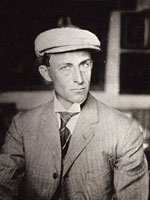Dayton Aviation Heritage National Historical Park [OH]
The Dayton Aviation Heritage National Historical Park celebrates the history and accomplishments of Wilber Wright (1867-1912), Orville Wright (1871-1948), and Paul Laurence Dunbar (1872-1906). Other topics addressed include changes in Air Force aviation technology. Sights include two interpretive centers; the Wright brothers' printing office, styled to period; a Wright brothers' bicycle shop; the brothers' third airplane, built in 1905; the Huffman Prairie Flying Field; and Dunbar's final residence. The Wright brothers are best known for creating the world's first successful airplane, while Dunbar was an African American poet celebrated for his 1896 poem "Lyrics of a Lowly Life."
The park offers two introductory films; exhibits; period rooms; guided tours of the Wright Cycle Company building, Wright-Dunbar Village, and the Huffman Prairie Flying Field; guided bicycle tours; children's programs; curriculum-based educational programs; and Junior Ranger activities. Tours of the Wright Cycle Company building are available on request only, and reservations are required for groups. Reservations are required for all school programs. The website offers an interactive timeline.
